Beef Tenderloin with Red Wine Sauce
This post may contain affiliate links. Read my full disclosure policy.
Wow your guests with ease! My roasted beef tenderloin paired with a rich red wine sauce is simple, sophisticated, and foolproof.
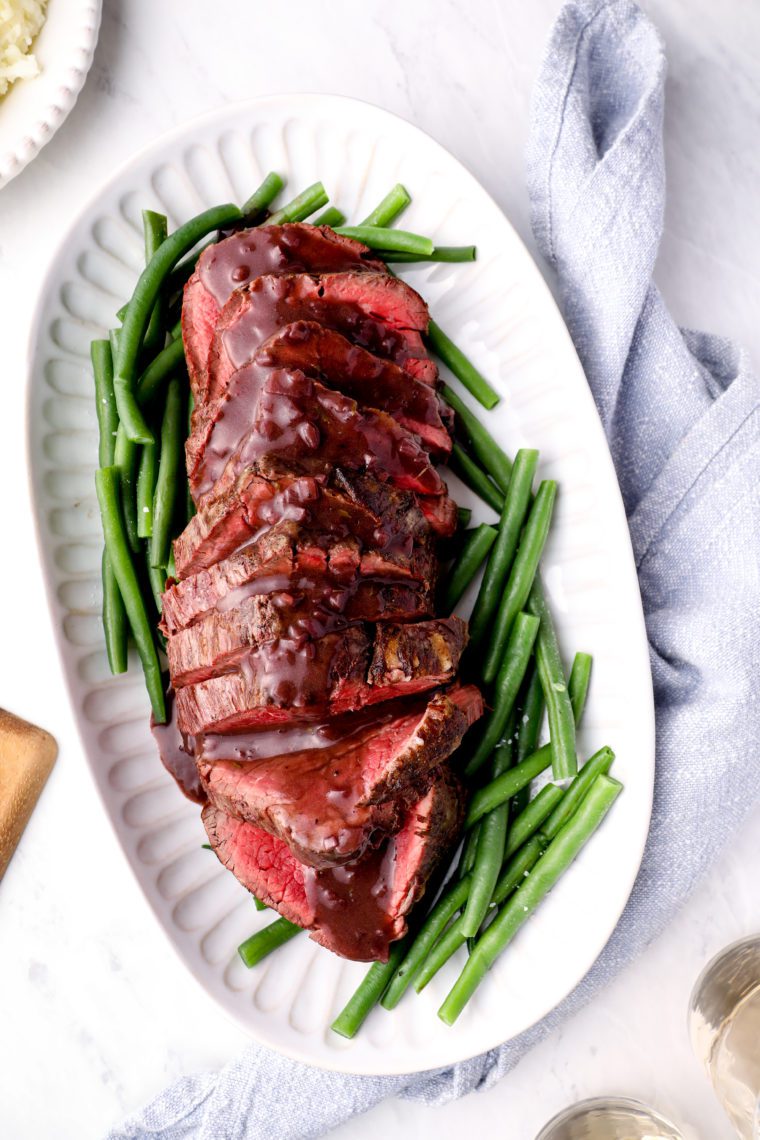
This beef tenderloin recipe is my #1 go-to recipe for holidays and special occasions. It never fails to impress, and my foolproof method ensures perfectly cooked beef every time, with no guesswork! The tenderloin is paired with a gorgeous French-style red wine reduction sauce, made by simmering a mixture of butter, shallots, red wine, and beef broth until the flavors deepen and intensify. Once reduced, a beurre manié (or flour and butter paste) is whisked in to thicken the sauce and give it a glossy sheen—yes, it’s fancy!
A great bonus is that the sauce can be prepared mostly in advance, so there’s very little fussing at the last minute. This beef tenderloin is truly the best of both worlds: simple to prepare yet incredibly delicious.
Table of Contents
“Voted best Christmas dinner ever! That is high praise. I served it with your thyme roasted carrots, shallot green beans and mashed potatoes. Thank you!”
Technique: Searing & Roasting Beef Tenderloin
Sear-roasting is an excellent method for cooking beef tenderloin. You begin by searing the tenderloin on the stovetop to create a beautifully crusty, brown exterior—this adds incredible flavor and texture to the lean cut. Next, transfer it to the oven and cook to your preferred doneness, using a leave-in meat thermometer with a remote monitor. These are readily available on Amazon or at kitchen stores and are a worthwhile investment for cooking pricey cuts like tenderloin. Plus, it’s great for other dishes too, like your Thanksgiving turkey.
What You’ll Need To Make Roast Beef Tenderloin With Red Wine Sauce
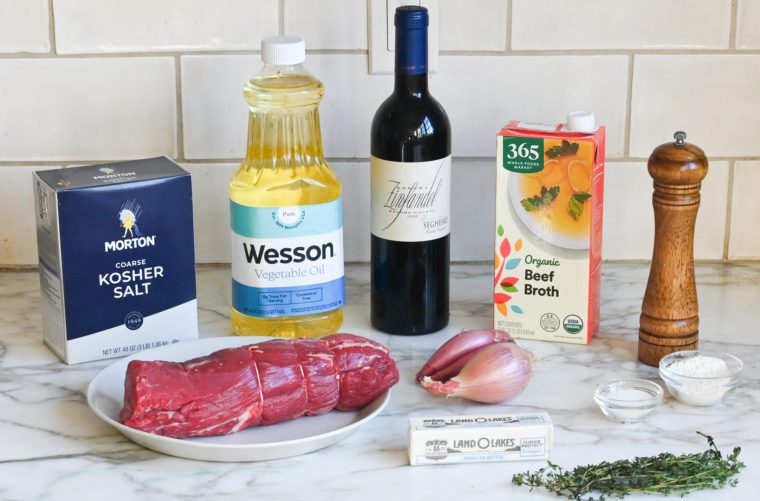
- Beef tenderloin: The most tender and expensive cut of beef available, beef tenderloin refers to the whole tenderloin before it is sliced into steaks. Once cut, those steaks are referred to as filet mignon (used in recipes like steak au poivre or pan-seared steaks). Beef tenderloin can be labeled and sold in different ways depending on the butcher or retailer. Common labels include “whole tenderloin,” “filet mignon,” “Chateaubriand,” or “tenderloin roast.”
- Butter: Provides richness and flavor. A portion is used for sautéing shallots, while the rest is combined with flour to create a beurre manié, which thickens the sauce.
- Shallots: Adds a sweet and mild onion flavor to the sauce.
- Red wine: Infuses the sauce with rich, fruity flavors and adds depth of color.
- Beef broth: Provides a savory base for the sauce; also used to deglaze the pan after roasting the beef.
- Thyme sprigs: Adds aromatic herbal notes to the sauce.
- All-purpose flour: Mixed with butter to create a beurre manié, a thickening agent for the sauce, giving it a smooth and velvety texture.
- Jump to the printable recipe for precise measurements
Step-by-Step Instructions
Step 1: Make the Sauce
Melt 5 tablespoons of the butter in a medium saucepan.
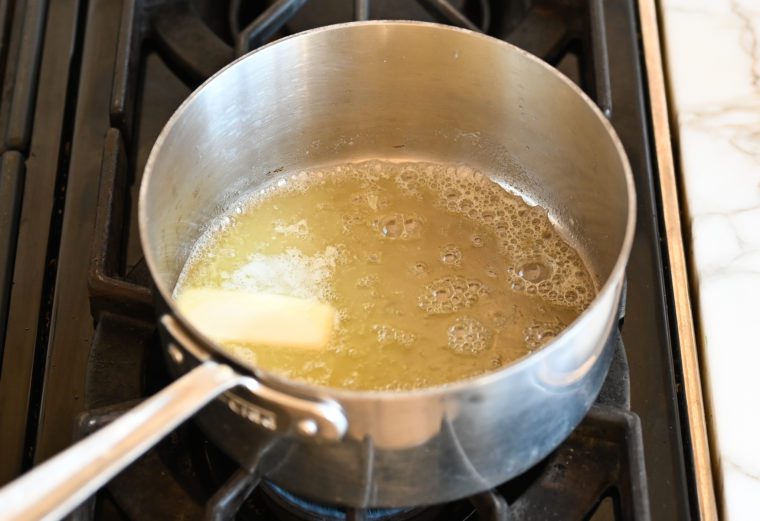
Add the shallots.
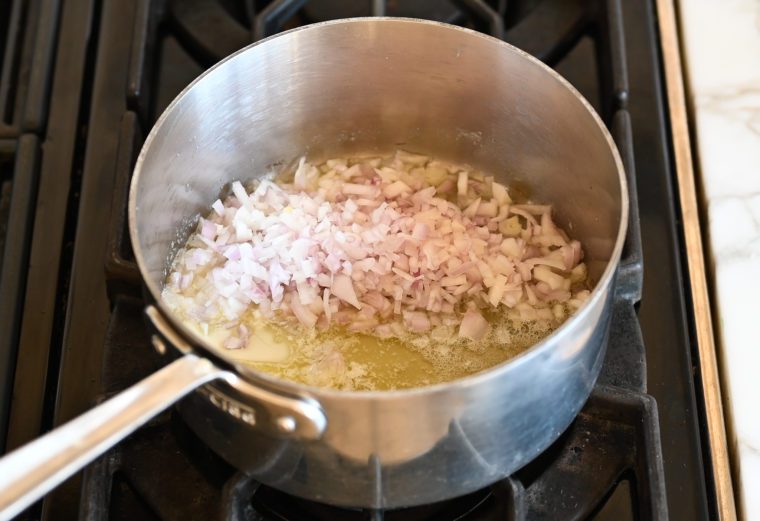
Cook over medium-low heat until soft and translucent, 7 to 8 minutes.
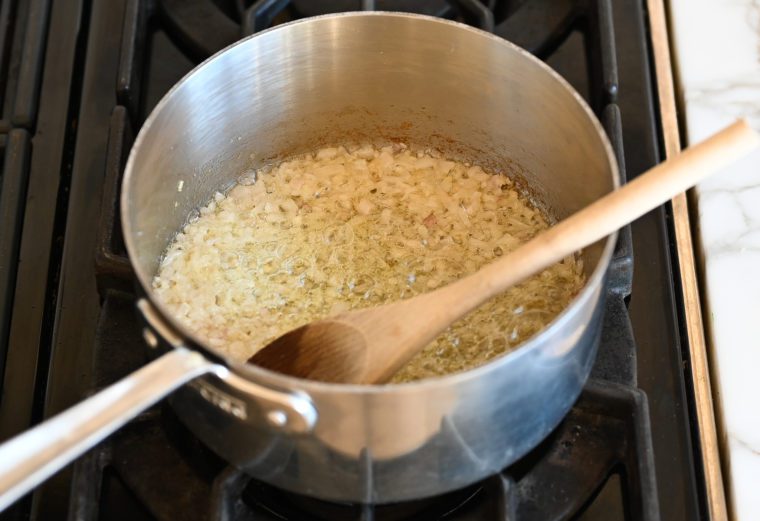
Add the wine, beef broth, thyme sprigs, salt, pepper and sugar, and bring to a boil.
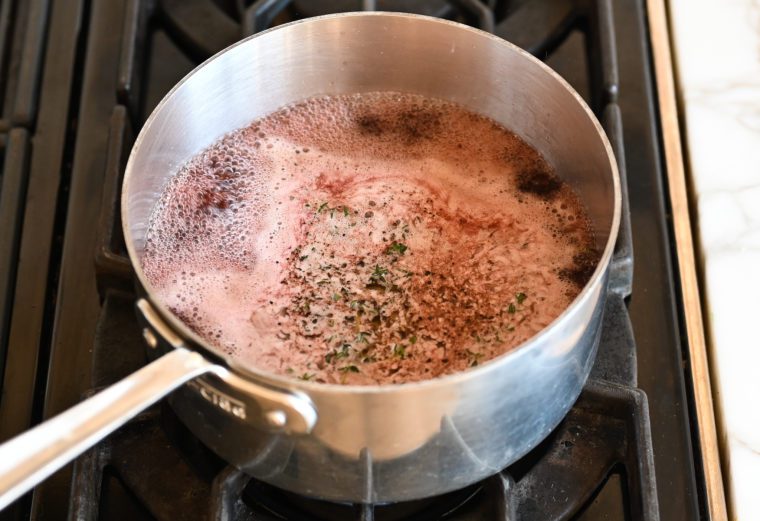
Cook over medium heat for about 30 minutes, or until the liquid is reduced by about half.
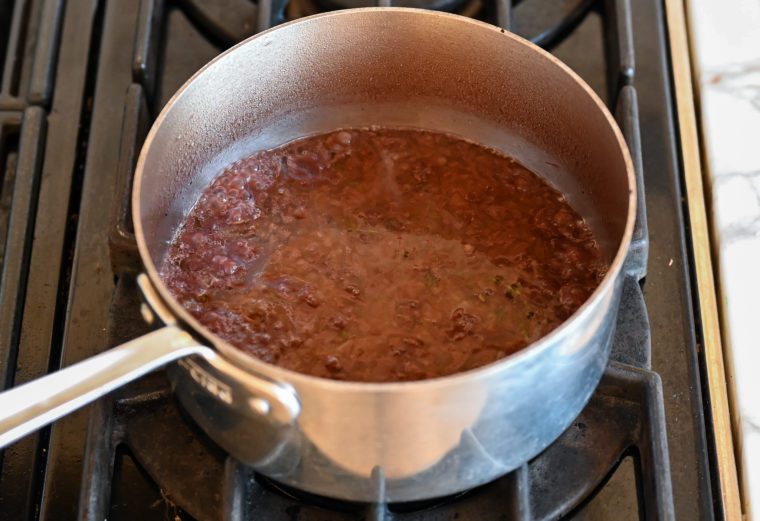
While the liquid is reducing, place the remaining 3 tablespoons of butter in a small bowl. Soften in the microwave (if necessary), then add the flour. Using a spoon, mix together into a paste. This is called a beurre manié, and it’s used to thicken sauces.
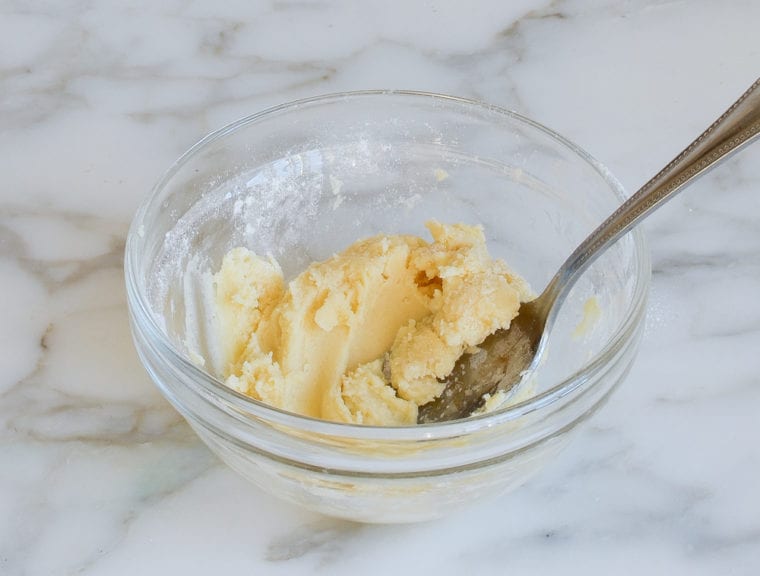
Once the wine mixture is reduced, reduce the heat to low and remove the thyme sprigs. Whisk the flour-butter mixture, a tablespoon at a time, into the simmering liquid, and simmer for a few minutes, until the sauce is thickened. The sauce can be made up to this point and refrigerated several days ahead of time.
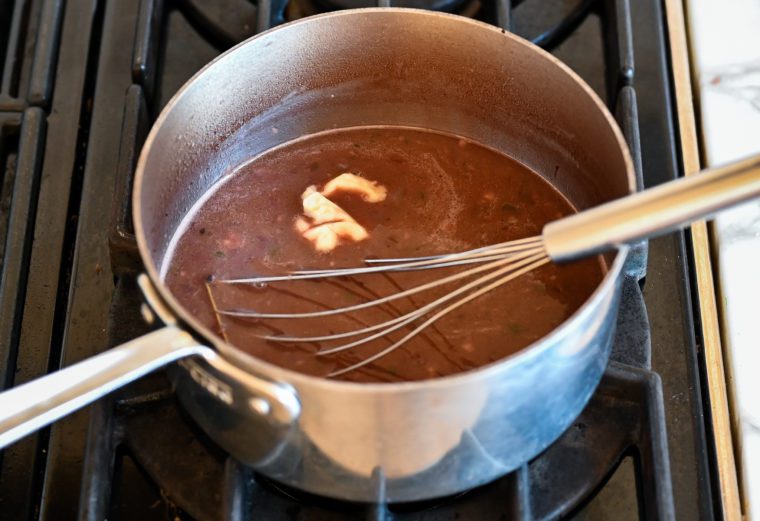
Step 2: Roast the Beef Tenderloin
Begin by seasoning the beef with kosher salt and freshly ground black pepper. Don’t be shy with the seasoning; it needs a lot.
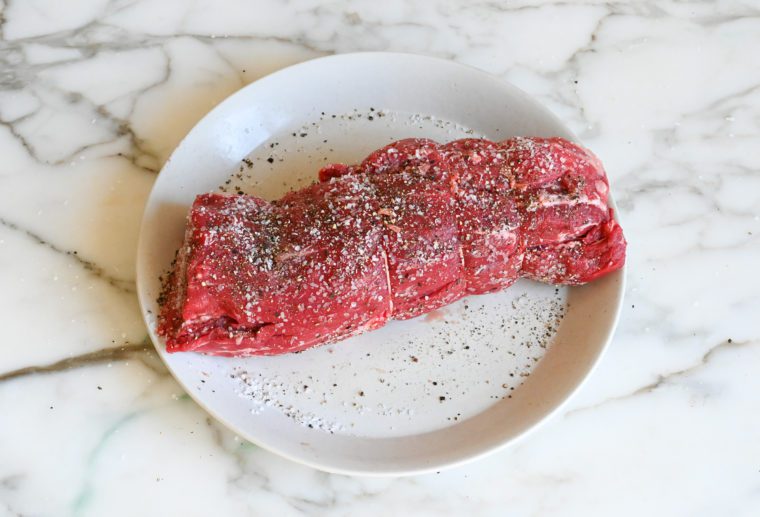
Heat the oil in an oven-proof skillet over medium-high heat until almost smoking. Cook, turning with tongs, until well browned with a nice crust on all but one side, about 10 minutes total.
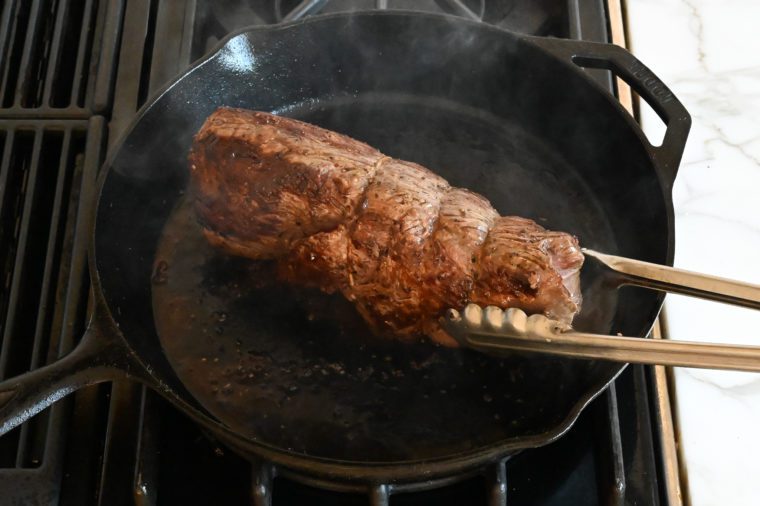
Turn the tenderloin so that the un-seared side is down and transfer the skillet directly to a 400°F oven.
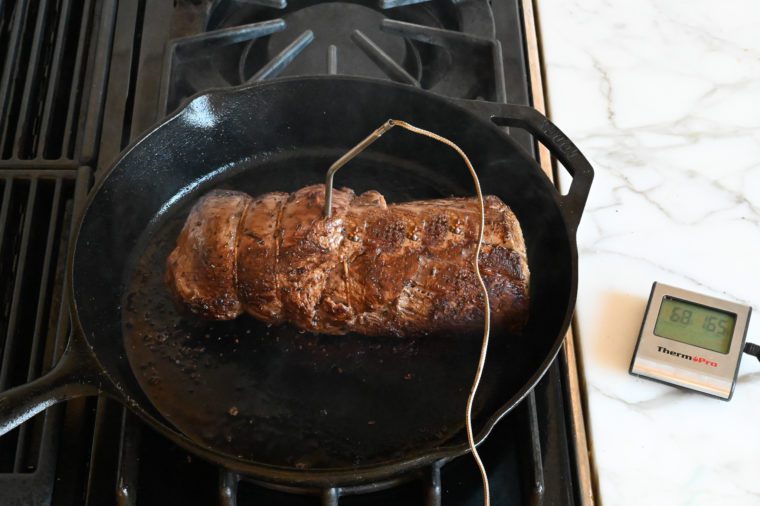
Roast until a thermometer inserted into the center of the meat registers 120ºF-125°F for medium-rare, 15 to 20 minutes, or until done to your liking. (Note that a perfect medium-rare roast will register around 130°F, but the internal temperature of the meat will continue to rise 5-10°F after it is removed from the oven, so it’s best to pull it out a little early to account for the carry-over cooking.) If you prefer your roast cooked to medium, pull it out of the oven at 130°F.
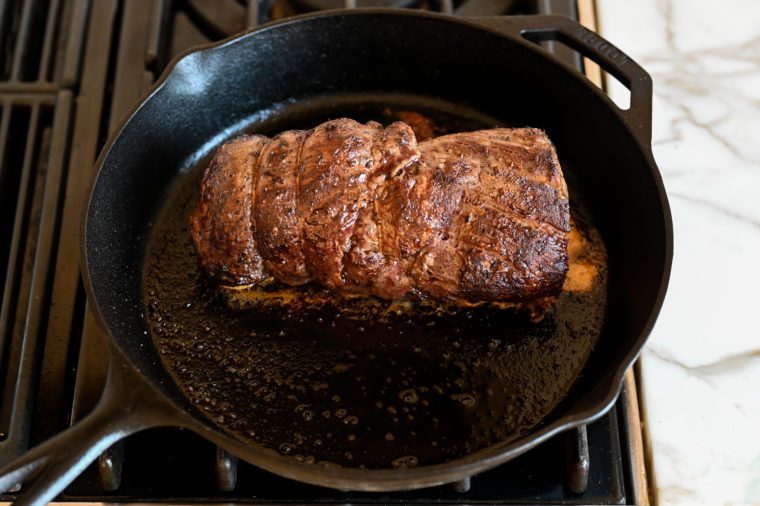
Step 3: Finish the Sauce & Carve the Tenderloin
Transfer the roast to a carving board (preferably with a well for collecting juices) and let it rest at room temperature, covered loosely with aluminum foil, for 10 to 15 minutes. This allows the juices to redistribute from the outside of the roast throughout the whole roast, making the tenderloin juicy. If you slice it too soon, the juices will pour out of it.
Meanwhile, pour off the fat from the roasting pan. Set the pan on the stovetop and add the beef broth. Bring the broth to a boil, using a wooden spoon to scrape the fond (brown bits) from the bottom of the pan.
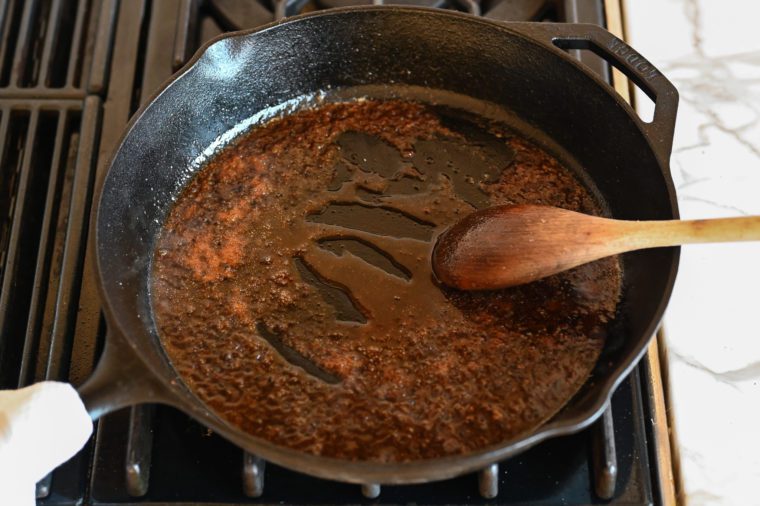
Add the flavorful broth to the red wine sauce, and bring the sauce to a simmer.
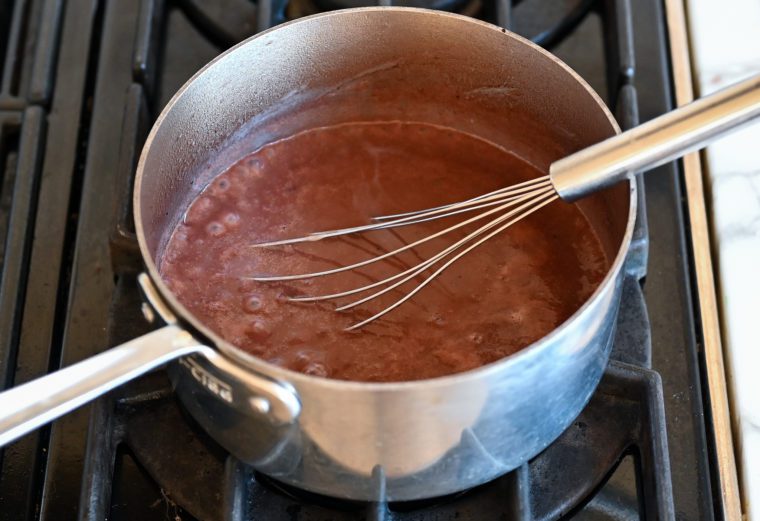
Carve the roast into 1/3-inch-thick slices.
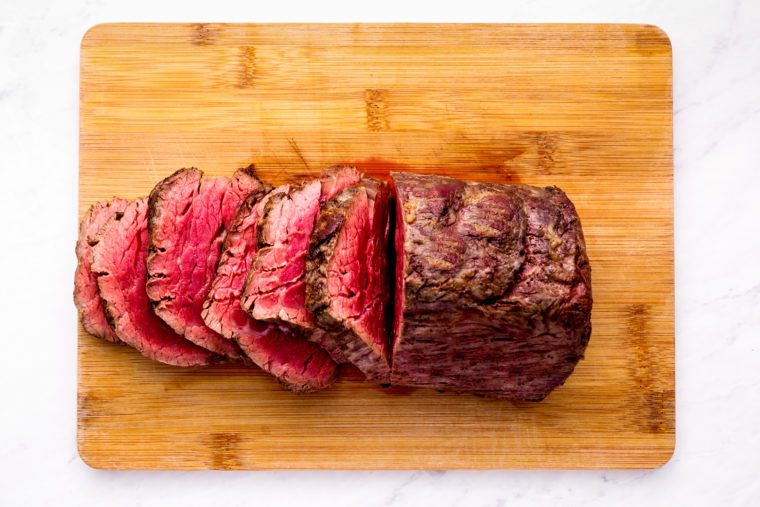
Serve the beef, passing the red wine sauce at the table.
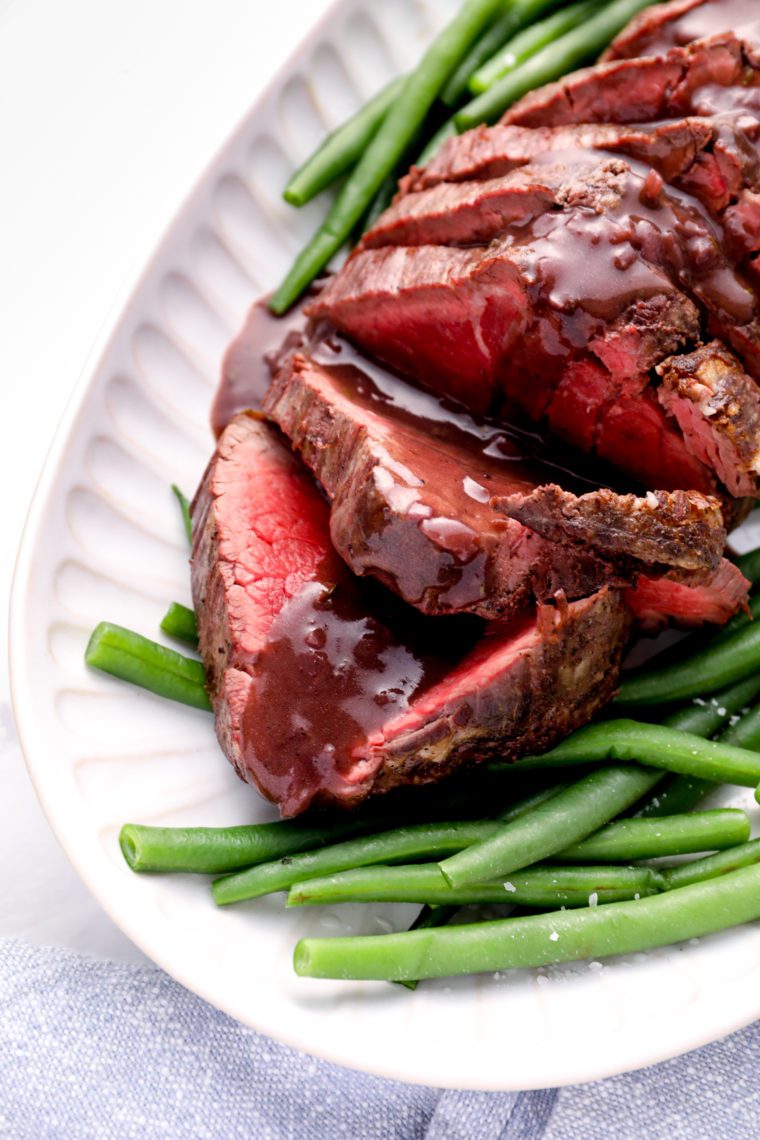
Frequently Asked Questions
Your tenderloin may have some butcher’s twine tied around one end of it; butchers often tie tenderloin up near the tapered end so that it is the same thickness all the way around. If yours comes that way, leave the string on until after it’s cooked. If it doesn’t, no worries—no need to do any tying.
When selecting a wine for the sauce, any red variety such as Merlot, Pinot Noir, Cabernet Sauvignon, Syrah, or Red Zinfandel will work well. It’s not necessary to overthink it or use anything too pricey; opt for a bottle that’s inexpensive yet still enjoyable to drink. Always avoid supermarket “cooking wines,” which contain salt and additives.
Unfortunately, I don’t recommend searing the beef in advance due to food safety concerns. Sear the beef just before cooking to be safe.
As a general guideline, plan for about 8 ounces (225 grams) of beef tenderloin per person for a generous serving. However, this can vary based on individual appetites and what other dishes you’re serving.
You May Also Like
Video Tutorial
Beef Tenderloin with Red Wine Sauce
Wow your guests with ease! My roasted beef tenderloin paired with a rich red wine sauce is simple, sophisticated, and foolproof.
Ingredients
For the Sauce
- 8 tablespoons unsalted butter, divided
- ¾ cup finely chopped shallots, from 2-3 large shallots
- 1¼ cups red wine
- 3 cups beef broth
- 6 fresh thyme sprigs
- ¼ teaspoon kosher salt
- ⅛ teaspoon ground black pepper
- 1 teaspoon sugar
- 2 tablespoons all-purpose flour
For the Beef
- 1 (2 to 3 lb) center-cut beef tenderloin roast
- Kosher salt (½ teaspoon per pound of beef)
- Freshly ground black pepper (¼ teaspoon per pound of beef)
- 2 tablespoons vegetable oil
- ¼ cup beef broth
Instructions
For the Sauce
- Melt 5 tablespoons of the butter in a medium saucepan. Add the shallots and cook over medium-low heat, stirring occasionally, until soft and translucent, 7 to 8 minutes. Add the wine, beef broth, thyme sprigs, salt, pepper and sugar, and bring to a boil. Cook over medium heat for about 30 minutes, or until the liquid is reduced by about half.
- While the liquid is reducing, place the remaining 3 tablespoons of butter in a small bowl and soften in the microwave, if necessary (it should be soft but not melted). Add the flour and, using a small spoon, mix into a smooth paste.
- Once the wine mixture is reduced, reduce the heat to low and remove the thyme sprigs. Whisk the flour-butter paste, a tablespoon at a time, into the simmering liquid, and simmer for a few minutes, until the sauce is thickened. Set aside. (The sauce can be made up to this point and refrigerated up to 3 days ahead of time.)
For the Tenderloin
- Let the beef stand at room temperature for 1 hour before roasting. Set an oven rack in the middle position and preheat the oven to 400°F.
- Season the beef all over with kosher salt and pepper. Heat the oil in an oven-proof skillet over medium-high heat until almost smoking. Cook, turning with tongs, until well browned on all but one side, about 10 minutes total. Turn the tenderloin so that the un-seared side is down, and transfer the skillet directly to the preheated oven. (If your pan isn't oven-proof, transfer the beef to a lightly oiled roasting pan.) Roast until a thermometer inserted into the center of the meat registers 120°F-125° for medium rare, about 15 minutes, or until done to your liking (115°F-120°F for rare, 130°F-135°F for medium). Keep in mind that these temperatures account for the fact that the temperature will continue to rise about 5 degrees while the meat rests.
- Transfer the meat to a carving board (preferably with a well for collecting juices) and let it rest, covered loosely with aluminum foil, for 10 to 15 minutes. Place a dishtowel or oven mitt over the handle of the roasting pan to remind yourself that it's hot.
- Meanwhile, carefully discard the fat from the roasting pan (remember that the handle is hot!). Set the pan on the stovetop and add the ¼ cup of broth. Bring the broth to a boil and, using a wooden spoon, scrape the fond, or brown bits, from the bottom of the pan. Add the flavorful broth to the red wine sauce, and then bring the sauce to a simmer.
- Carve the tenderloin into ½-inch-thick slices. Serve the beef, passing the red wine sauce at the table.
Pair with
Nutrition Information
Powered by ![]()
- Per serving (6 servings)
- Calories: 1,001
- Fat: 61 g
- Saturated fat: 26 g
- Carbohydrates: 9 g
- Sugar: 3 g
- Fiber: 1 g
- Protein: 49 g
- Sodium: 1093 mg
- Cholesterol: 233 mg
This website is written and produced for informational purposes only. I am not a certified nutritionist and the nutritional data on this site has not been evaluated or approved by a nutritionist or the Food and Drug Administration. Nutritional information is offered as a courtesy and should not be construed as a guarantee. The data is calculated through an online nutritional calculator, Edamam.com. Although I do my best to provide accurate nutritional information, these figures should be considered estimates only. Varying factors such as product types or brands purchased, natural fluctuations in fresh produce, and the way ingredients are processed change the effective nutritional information in any given recipe. Furthermore, different online calculators provide different results depending on their own nutrition fact sources and algorithms. To obtain the most accurate nutritional information in a given recipe, you should calculate the nutritional information with the actual ingredients used in your recipe, using your preferred nutrition calculator.

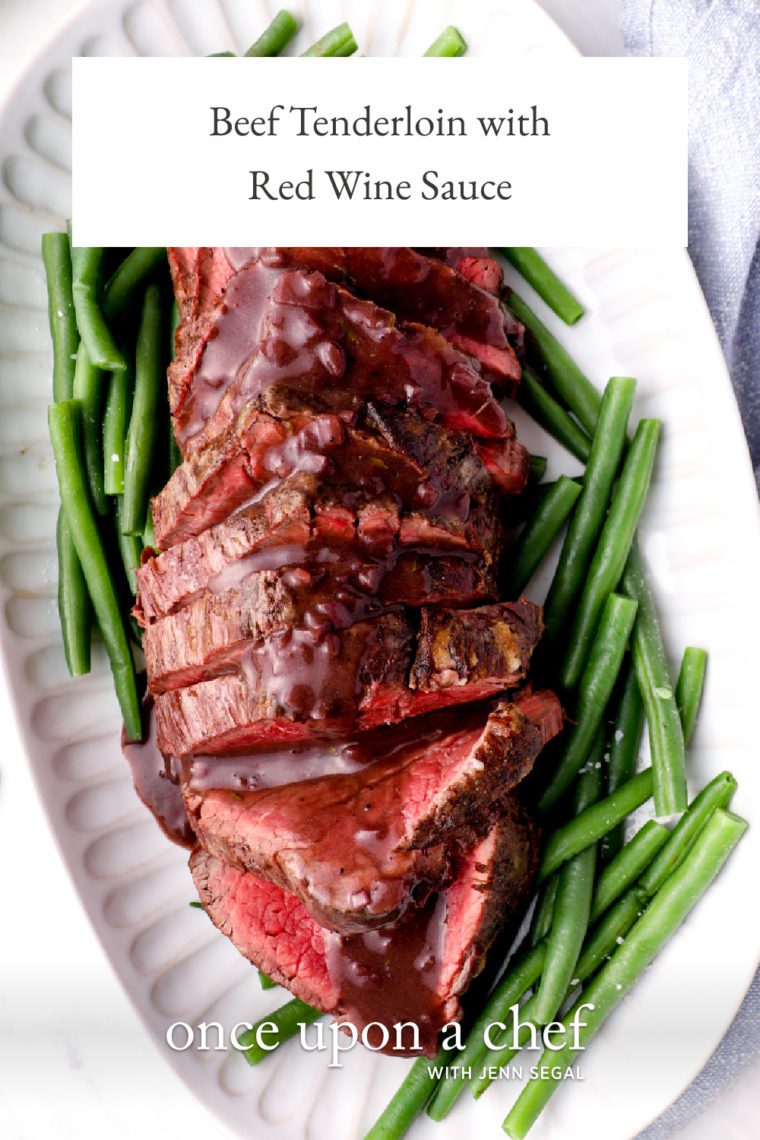
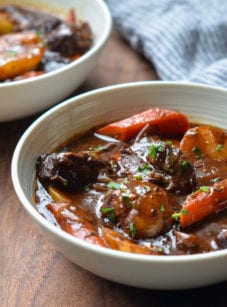
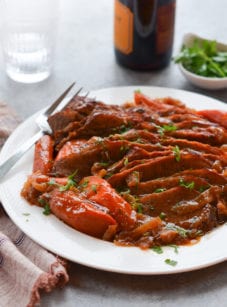

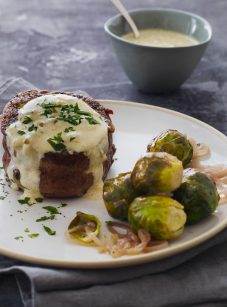
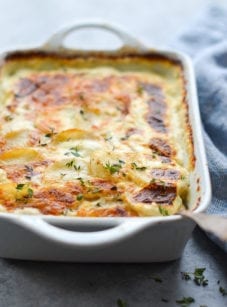
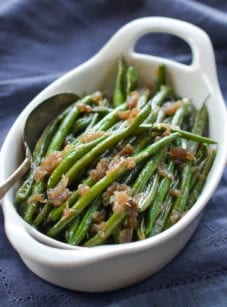

Thanks for this! I’m going to sous vide 2 tenderloins at different temps so we can appease everyone but, more importantly, to free up oven space. I’m then going to torch them with a Searzall to get some browning, and serve a trio of sauces at the table. Looks like this one is going to make the cut.
QUESTIONS: My assumption is that won’t really yield any juices/fat to add to the broth. Is there anything else you would recommend adding to the broth, preferably that can be done a few days in advance (and thus reheated by someone other than me with no fuss as the meal is approaching)?
Hi Brad, if you can find demi-glace (likely at a specialty store) you could use a little of that. Hope you enjoy!
Hi Jenn. I made the sauce last night for my dinner party tonight and although I used less flour than called for , the sauce is really thick. ( maybe I reduced it too much?) I know it will thin a bit when I add the roasting juices, but any other suggestions to make it a little less thin before I serve ? Thanks! I really enjoy your recipes and blog and have made many of your recipes with much success!
Hi Liz, It sounds like maybe you reduced it a little too much. First, reheat it and see if it still needs to be thinned. If it does, you can add water or broth, just a tiny bit at a time until you get the desired consistency. Hope that helps and that everyone enjoys!
Hi Jenn
I have 2 rather large tenderloins I need to cook. They are bigger than the largest skillet I have. Therefore I was thinking of taking a large roasting pan and putting that over two burners to try and sear both at the same time and then using that roasting pan to transfer both to the oven. Do you have another suggestion? Also, would you recommend convection or traditional baking?
Thanks
George
Hi George, I think that’s a great solution. And I would definitely recommend traditional baking. Convection heat is good for baking, but it can dry out a roast. Hope everyone enjoys!
Hi Jenn,
What size roasting pan would you recommend?
Hi Carol, If you have one, you can use an oven-proof skillet. If not, I’d use a roasting pan just large enough to fit the tenderloin. Hope you enjoy!
Hello Jen, I see the Beaujolais Nouveau in your pictures although you mentioned “heavier” wines, did you get good results with that wine? Would a slurry of water/cornstarch work as a thickener here or does beuree manie give preferred results? Thank you.
Hi Denise, Yes, the Beaujolais Nouveau does work here and I’d stick with the beuree manie for this. I find that a cornstarch slurry can dilute the flavor of a sauce. Hope that helps!
Can I use this same recipe to cook a prime strip roast? How would it need to be adapted, if so?
Thanks..Jane
Sure, Jane, that should work. Just be sure to use a cooking thermometer as the cooking time will differ. Hope you enjoy. 🙂
Can you sub lamb for the beef?
Hi Kari, I haven’t tried it myself, but theoretically, it should work. Just make sure to use a meat thermometer. Please LMK how it turns out if you try it!
Hello I have a question can I cast iron skillet as my oven proof skillet??
Sure, Austin – a cast iron skillet is ideal.
List of ingredients and amounts for red wine sauce
Hi Mike, It sounds like you are just looking at the portion of the page that has the pictures with some instructions underneath. If you scroll down a bit to under the pictures, you’ll find the full recipe. Alternatively, at the very top of the page, to the right of the recipe name, you’ll see an orange/red button that says Jump to Recipe – if you click on that, it will take you directly to the recipe. Hope that clarifies!
When you say to pour off the fat from the roasting pan- what exactly do you mean? The stuff in the bottom of the skillet that was in the oven? The juices on the cutting board the meat is resting on?
Hi Jenn, you’ll just be pouring off the liquidy fat from the pan (but you don’t want to include the little browned bits on the bottom of the pan as they will be added to the sauce). Hope that clarifies!
I made this recipe last year for my family Christmas and it was a HUGE hit – and that’s saying something because (other than me) my family does not really care for meat. I followed the instructions exactly and everything came out really amazing, especially the sauce. SO Good I have multiple requests and so will be making it again this year.